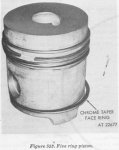- 1,825
- 80
- 48
- Location
- West Tennessee
Found this in an official document:
"Though not a maintenance fault, failures of multifuel engines created the requirement for a major off-shore maintenance effort and a sizeable supply problem. In January 1967, more than 300 5-ton trucks were deadlined in Vietnam because of inoperative multifuel engines (a similar condition existed for 2½-ton trucks) due to cracked blocks, blown head gaskets, valve stems and connecting rods. A study indicated that many failures occurred between 9,000 and 10,000 miles and that the units hardest hit were the line haul transportation units whose engines were subjected to continuous use (2,000 miles per month in Vietnam). The prospect for improvement at this point was negligible because of the lack of repair parts and overhaul capacity. Multifuel engines powered both 2½- and 5-ton trucks. A similar condition also existed in Thailand. The annual engine replacement rate of 6 per 100 vehicles per year increased to a rate of one engine per vehicle per year.
By the summer of 1967, an airlift program, Red Ball Express was put into effect in an attempt to alleviate the shortage of engines and repair parts. The Red Ball Express was designed to be used in lieu of normal procedures exclusively to expedite repair parts to remove equipment from deadline status. Reserved and predictable airlift was made available for this purpose. The seriousness of the situation led to a multifuel engine conference on 28 August 1967. The conference resulted in several recommendations, the most significant of which was that three multifuel engines, LD 427, LD 465, and LDS 465, were to be placed under Closed Loop Support management because of the inability of units in the field to cope with the maintenance problem. A further recommendation was made that return to the Continental U.S. be authorized for vehicles that could not be supported with multifuel repair parts or replacement engine assemblies. Because a large percentage of the producers' production capacity was consumed in end items assembly, some repair parts and new replacement engine assemblies were not readily available. Department of the Army approved the recommendations of the conference and directed that necessary retrograde, overhaul, and shipping operations be initiated immediately.
Although the conference had focused attention on the supply aspect and premature failure of engines, significant intangibles remained unsolved, including proper operation of vehicles and user maintenance. Because of the characteristic difference of the multifuel engine from the standard internal combustion engine, periodic maintenance and specific mandatory operational procedures differed sharply from procedures used with other vehicles and required closer attention. Simply put, despite years of testing effort, the multifuel engine did not possess the ruggedness and tolerance to withstand the abuses inherent in field operations."
hope this is interesting to ya'll.
Regards,
David Doyle
"Though not a maintenance fault, failures of multifuel engines created the requirement for a major off-shore maintenance effort and a sizeable supply problem. In January 1967, more than 300 5-ton trucks were deadlined in Vietnam because of inoperative multifuel engines (a similar condition existed for 2½-ton trucks) due to cracked blocks, blown head gaskets, valve stems and connecting rods. A study indicated that many failures occurred between 9,000 and 10,000 miles and that the units hardest hit were the line haul transportation units whose engines were subjected to continuous use (2,000 miles per month in Vietnam). The prospect for improvement at this point was negligible because of the lack of repair parts and overhaul capacity. Multifuel engines powered both 2½- and 5-ton trucks. A similar condition also existed in Thailand. The annual engine replacement rate of 6 per 100 vehicles per year increased to a rate of one engine per vehicle per year.
By the summer of 1967, an airlift program, Red Ball Express was put into effect in an attempt to alleviate the shortage of engines and repair parts. The Red Ball Express was designed to be used in lieu of normal procedures exclusively to expedite repair parts to remove equipment from deadline status. Reserved and predictable airlift was made available for this purpose. The seriousness of the situation led to a multifuel engine conference on 28 August 1967. The conference resulted in several recommendations, the most significant of which was that three multifuel engines, LD 427, LD 465, and LDS 465, were to be placed under Closed Loop Support management because of the inability of units in the field to cope with the maintenance problem. A further recommendation was made that return to the Continental U.S. be authorized for vehicles that could not be supported with multifuel repair parts or replacement engine assemblies. Because a large percentage of the producers' production capacity was consumed in end items assembly, some repair parts and new replacement engine assemblies were not readily available. Department of the Army approved the recommendations of the conference and directed that necessary retrograde, overhaul, and shipping operations be initiated immediately.
Although the conference had focused attention on the supply aspect and premature failure of engines, significant intangibles remained unsolved, including proper operation of vehicles and user maintenance. Because of the characteristic difference of the multifuel engine from the standard internal combustion engine, periodic maintenance and specific mandatory operational procedures differed sharply from procedures used with other vehicles and required closer attention. Simply put, despite years of testing effort, the multifuel engine did not possess the ruggedness and tolerance to withstand the abuses inherent in field operations."
hope this is interesting to ya'll.
Regards,
David Doyle




